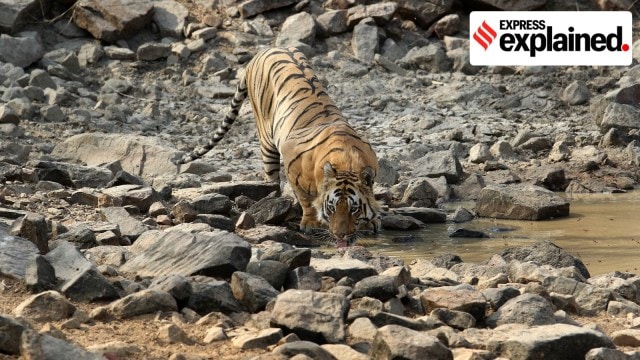Maharashtra to translocate tigers to Sahyadri reserve: Role of wildlife corridors in tiger conservation
Wildlife corridors are essentially habitats and pathways that connect wildlife populations, which are fragmented by human settlements and infrastructure works.
 A tiger at Tadoba-Andhari Tiger Reserve (TATR) in Chandrapur district. (Photo: Prashant Nadkar)
A tiger at Tadoba-Andhari Tiger Reserve (TATR) in Chandrapur district. (Photo: Prashant Nadkar)To revive the population of tigers in Sahyadri Tiger Reserve (STR) — the lone tiger reserve in the Maharashtra western region — the state’s forest department will soon translocate tigers from Tadoba-Andhari Tiger Reserve (TATR) in Chandrapur district.
However, the objective of the project can only be achieved if the Sahyadri-Konkan wildlife corridor — forests in STR, Goa, and Karnataka serve as the corridor — is secure enough and free from human disturbances, according to the experts.
Here is a look at what exactly wildlife corridors are and their role in tiger conservation.
But first, why is Maharashtra planning to translocate tigers to STR?
The STR, located in northern Western Ghats, was established in January 2010 and straddles Kolhapur, Satara, Sangli, and Ratnagiri districts in western Maharashtra. It comprises Chandoli National Park and Koyna Wildlife Sanctuary.

The tiger population in the region has been historically low due to poaching, poor prey base, and changing habitat. Even after the STR was notified, the number of tigers did not increase as breeding tigers did not colonise the reserve.
Photo evidence of tiger presence within the boundaries of STR has been few and pugmark evidence has shown the presence of seven to eight tigers from time to time.
One way the population can increase is through the inflow of tigers from the forests, located towards the south of STR, in Goa and Karnataka, especially with the strengthening of the wildlife corridor. However, the spike in tiger numbers can take years this year.
As a result, the translocation of tigers has been opted for short-term outcomes.
Is translocation the best approach for tiger recovery?
Tiger translocation projects have been undertaken in India since 2008. Sariska Tiger Reserve, in 2008, and Panna Tiger Reserve, in 2009, have witnessed successful tiger reintroduction and translocation projects. There have also been failures and shelving of reintroduction plans, like in the case of Satkosia Tiger Reserve in Odisha, which was the country’s first inter-state translocation project.
Anup Nayak, former member secretary of National Tiger Conservation Authority and Additional Director General of Project Tiger, believes translocation initiatives have been a mixed bag so far and they should be taken up as a last resort. “Before choosing translocation, other available options such as habitat improvement, prey augmentation, strengthening of tiger corridors, and vigilance improvement should be assessed,” Nayak said.
He also said tiger corridors are crucial for the long-term and sustainable success of a translocation project, “Even after translocations, one must ensure that corridors are strengthened and they are free of major disturbances. This will ensure dispersal of tigers to other source population areas.”
In Satkosia, Nayak said, that poor management of community apprehensions was a key reason for the failure of the translocation project. Before and after the reintroduction of one male and one female tiger from Kanha in 2018, locals in Satkosia Tiger Reserve had violently protested the plan.
Soon after translocation, Sundari, the tigress, reportedly mauled a local woman to death and later, a man fell prey to a tiger attack. This sparked violent protests against the forest department. Later, Mahavir, a male tiger, died after it got caught in a snare, which caused fatal injuries..
“The whole situation was managed poorly. Tigers move around in their new habitats and they naturally are expected to explore around. The villagers had to be taken into confidence before the reintroduction,” Nayak added.
What role do wildlife corridors play in conservation?
Corridors are essentially habitats and pathways that connect wildlife populations, which are fragmented by human settlements and infrastructure works.
They are crucial for the long-term survival of the tiger population as they help guard against localised extinctions and ensure the exchange of gene flow, which helps in population diversity. Tigers have large home ranges and often travel long distances in search of mates and food. In doing so, they make use of these wildlife corridors and cross several human-dominated landscapes. The role played by corridors in conservation is a well-established one and has been incorporated into policy decisions as well.
Mitigation measures such as underpasses, and wildlife crossings are now routinely ordered to safeguard tigers and other wildlife in projects where linear infrastructure projects fragment habitats.
Litigation, advocacy, and policymaking have all contributed to this. The construction of an overpass on the National Highway- 7 to protect the migratory route of tigers underneath between the Kanha and Pench Tiger Reserves is one instance of embedding mitigation measures to protect corridors.
Tigers routinely use the space beneath the elevated stretch of the highway to cross the forests.
In 2014-15, the National Tiger Conservation Authority and Wildlife Institute of India (WII) mapped 32 major tiger corridors in the country across four broad tiger landscapes – Shivalik Hills and Gangetic plains, Central India and Eastern Ghats, Western Ghats, and the North East Hills.
What is the importance of the Sahyadri-Konkan corridor?
The Sahyadri-Konkan corridor or the Sahyadri-Radhanagari-Goa-Karnataka corridor is crucial for the long-term survival of tiger populations in northern Western Ghats. This corridor connects the source population area in Kali Tiger Reserve in Karnataka to the forests in Goa’s hinterland, which in turn provides tigers connectivity to Radhanagari Wildlife Sanctuary, conservation reserves in Sindhudurg district and STR.
The high occurrence of human-dominated settlements and development activities fragments this corridor at several locations, posing a threat to tiger movement and raising the chances of man-animal conflict. With authorities planning the translocation of tigers to Sahyadri, strengthening this corridor is crucial. Without those efforts, even a breeding population of tigers would face difficulties in dispersing to other forests.
Nirmal Kulkarni, director of the Mhadei Research Centre in Chorla Ghats, Karnataka, said that tigers from Kali Tiger Reserve disperse regularly towards Goa where the prey base is comparatively low.
Goa’s protected areas now have seven to eight tigers. However, the state’s forest department has resisted demands to declare a tiger reserve.
“I would emphasise that these corridors are not only important for wildlife but also for the water security of communities living around these forests in Goa and Karnataka. This is an important watershed area. Tigers are also worshipped here. We need better coordination between Maharashtra, Goa, and Karnataka to manage this issue,” Kulkarni said.
More Explained
Must Read
Buzzing Now
EXPRESS OPINION
Jun 13: Latest News
- 01
- 02
- 03
- 04
- 05

































